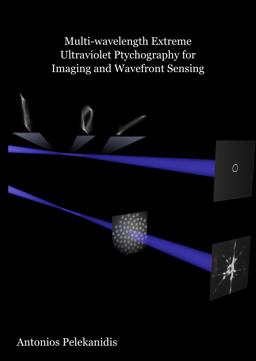2025-09-17
Multi-wavelength extreme ultraviolet ptychography for imaging and wavefront sensing
Publication
Publication
The need to accurately image microscopic features has led to the development of microscopes and complicated imaging techniques. Imaging systems can be divided into lens-based and lensless systems. In this thesis we study one lensless imaging technique called ptychography. In ptychography the object of interest is illuminated by a coherent light source. As the light transmits through or reflects from the object, it gets diffracted, and a camera captures the diffraction pattern. The object is placed on a moving stage and can move laterally to the laser beam. Therefore, we expose the camera to a series of diffraction patterns from different, but overlapping illuminated areas of the objects. Finally, we run a numerical reconstruction algorithm that gives complex-valued expressions of the object, and of the laser beam, which describes the wavefront at the object plane. Imaging resolutions in the nanometer range can be achieved with illuminating light sources in the extreme ultraviolet (XUV) and soft-x-ray (SXR) spectrum. Coherent XUV and SXR can be generated with tabletop sources via high harmonic generation (HHG), which is a non-linear process during which we generate high harmonics of a drive laser with wavelength typically in the infrared or visible spectrum. The output of the HHG process is a number of odd harmonics of the drive laser extending to the XUV and SXR range. In the second chapter we study the computational models for the propagation of the light wave from the object plane to the camera plane. Specifically, we compare three propagation models with user-defined pixel sizes for the object. We demonstrate that all three of them are equivalent, as they all originate from the Fresnel integral that describes the propagation of light under the paraxial approximation. However, each model has two alternative versions, which we also study and compare. In chapter 3 we investigate and experimentally validate chromatic aberration effects in HHG. For this purpose we perform ptychographic wavefront sensing (PWFS) measurements. By numerically backpropagating the reconstructed wavefronts to the generation plane of HHG, and associating the backpropagated wavefronts with the drive laser wavefront, wedraw conclusions about the physical processes of HHG. We varied the drive laser focus position with respect to the generation plane and calculated the focus positions of each high harmonic beam. The experimental results showed that there is strong chromatic aberration among the harmonic beams when the laser focus position is behind the generation plane. In chapter 4 we perform PWFS measurements for HHG beams carrying orbital angular momentum (OAM) generated by an OAM drive laser. OAM is a property of laser beams associated with a doughnut-shaped intensity profile and a topological charge. In this work we also perform a series of PWFS measurements, for varying laser focus positions and varying astigmatism levels in the drive laser, and study how the doughnut shape is affected in the far field and through the propagation of the HHG beams along the focus. We also study the broadening of the OAM modal content of the high harmonics when the drive laser beam has modal impurities, such as increased aberrations. In chapter 5 we study the imaging of an object using a multi-wavelength HHG beam. We introduce the concept of diversity, claiming that diversity within each polychromatic diffraction pattern and among diffraction patterns should facilitate ptychographic reconstructions. To confirm our hypothesis, we perform ptychographic imaging measurements with different illumination diversities. We add diversity by inserting a diffractive mask in the beamline upstream of the sample or by generating harmonics carrying OAM, as shown in chapter 4. We observe enhanced resolution and imaging quality when the beams are characterized by high diversity.
| Additional Metadata | |
|---|---|
| S. Witte (Stefan) , K.S.E. Eikema (Kjeld) | |
| VU University Amsterdam | |
| ASML, ARCNL, VU, UvA, RUG, NWO , Netherlands Organisation for Scientific Research (NWO) | |
| Organisation | EUV Generation & Imaging |
|
Pelekanidis, A. (2025, September 17). Multi-wavelength extreme ultraviolet ptychography for imaging and wavefront sensing. |
|

